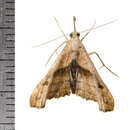Conservation Status
provided by University of Alberta Museums
Common and widespread; no concerns.
- license
- cc-by-nc
- copyright
- University of Alberta Museums
Cyclicity
provided by University of Alberta Museums
Adults are on the wing late May to August.
- license
- cc-by-nc
- copyright
- University of Alberta Museums
Distribution
provided by University of Alberta Museums
Newfoundland west to coastal British Columbia, south to Texas. In Alberta, it occurs widely in the Boreal Forest and Foothills regions.
- license
- cc-by-nc
- copyright
- University of Alberta Museums
General Description
provided by University of Alberta Museums
A small (2.0-2.6 cm wingspan) narrow-winged moth with dull reddish or brownish-grey forewings and paler hindwings. The forewings have a prominent, dark oblique median band that stops well before the costa, and a dark, bar-shaped reniform. The antemedian and postmedian lines are fine, and the later is curved. There is a yellow or orange patch on the outer margin below the apex, and a dark terminal line and grey fringe. The hindwings are pale, crossed by fine median and submedian bands, and darkening toward the margin and in particular in the region just before the anal angle. The palps are massive, in the male folded back up and over the head and thorax, and containing a large expansible yellowish tuft. The antennae are simple and both of the sexes are similar.
- license
- cc-by-nc
- copyright
- University of Alberta Museums
Habitat
provided by University of Alberta Museums
Coniferous and mixedwood forest.
- license
- cc-by-nc
- copyright
- University of Alberta Museums
Life Cycle
provided by University of Alberta Museums
Adults are nocturnal and come to lights and sugar baits. They have a long flight period, and it is possible that more than one brood annually. The larvae feed on the foliage of a wide variety of trees and shrubs as solitary defoliators, often within a silk webbing.
- license
- cc-by-nc
- copyright
- University of Alberta Museums
Trophic Strategy
provided by University of Alberta Museums
No Alberta data available. Elsewhere in Canada, recorded from a wide variety of trees and shrubs, but mainly confer trees, in particular Balsam fir (Abies balsamifera) and White spruce (Picea glauca). See Prentice, 1962 or Handfield, 1999 for lists of recorded hosts.
- license
- cc-by-nc
- copyright
- University of Alberta Museums
Palthis angulalis
provided by wikipedia EN
Palthis angulalis, the dark-spotted palthis, is a moth of the family Erebidae. The species was first described by Jacob Hübner in 1796. It is found from Newfoundland west to coastal British Columbia, south to Florida and Texas.
The wingspan is 20–26 mm. Adults are on wing from May to August in Alberta. There are two generations in much of the eastern part of its range, three or more generations from Missouri southward.
The larvae feed on various plants, including forbs, woody shrubs and trees (alder, aster, basswood, birch, chestnut, fir, sweetgale, goldenrod, ninebark, rhododendron, scrub oak and spruce).
References
- Wagner, David L.; Schweitzer, Dale F.; Sullivan, J. Bolling & Reardon, Richard C. (2011). Owlet Caterpillars of Eastern North America. Princeton University Press. ISBN 978-0691150420.
- "930551.00 – 8397 – Palthis angulalis – Dark-spotted Palthis Moth – (Hübner, 1796)". North American Moth Photographers Group. Mississippi State University. Retrieved March 24, 2020.
- Bartlett, Troy; et al. (May 23, 2017). "Species Palthis angulalis - Dark-spotted Palthis - Hodges#8397". BugGuide. Retrieved March 24, 2020.
- Robinson, E. & Anweiler, G. G. "Species Details Palthis angulalis". University of Alberta Museums. E.H. Strickland Entomological Museum. Retrieved November 12, 2020.

- license
- cc-by-sa-3.0
- copyright
- Wikipedia authors and editors
Palthis angulalis: Brief Summary
provided by wikipedia EN
Palthis angulalis, the dark-spotted palthis, is a moth of the family Erebidae. The species was first described by Jacob Hübner in 1796. It is found from Newfoundland west to coastal British Columbia, south to Florida and Texas.

The wingspan is 20–26 mm. Adults are on wing from May to August in Alberta. There are two generations in much of the eastern part of its range, three or more generations from Missouri southward.
The larvae feed on various plants, including forbs, woody shrubs and trees (alder, aster, basswood, birch, chestnut, fir, sweetgale, goldenrod, ninebark, rhododendron, scrub oak and spruce).
- license
- cc-by-sa-3.0
- copyright
- Wikipedia authors and editors


